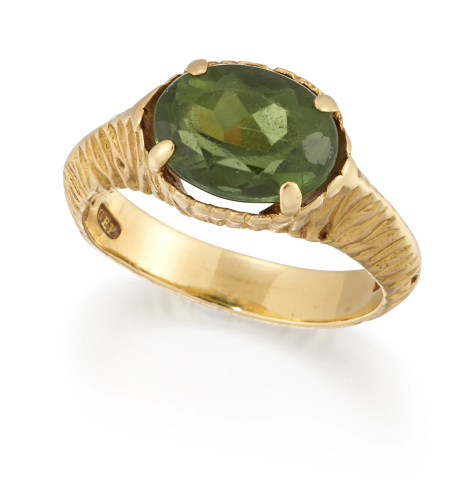Gilian Packard was a pioneering designer, known for her bold geometric designs incorporating geodes which rocked the 1960s jewellery scene. She was born in Newcastle-Upon-Tyne in 1938. She studied at Kingston-on-Thames’ School of Fine Arts, Central School of Arts and Crafts, and the Royal College of Art. Before enrolling at the Royal College, Packard worked for four months as a saleswoman at the Esprey store on Bond Street.
During her studies, Packard showed work at the 1961 International Exhibition of Modern Jewellery. The exhibition was designed to showcase a new generation of jewellery designers after the years of austerity which followed the Second World War. Within the next decade Packard was made the chair of the British branch of the World Council for Applied Arts and became the first female Freeman of The Worshipful Company of Goldsmiths. Both roles gave her reason to travel extensively abroad to ensure British involvement in international exhibitions. Her jewellery found great success abroad, especially in Japan and Germany. In 1968 she visited Peru and saw collections of Inca gold which had a profound impact on the designer and solidified her passion for bold designs and deep natural colours.
Packard sold her works through other UK jewellers in order to expand access to her pieces, and her workshop supplied her jewellery to 60 stores in England - including Museum Street’s famous Cameo Corner store, which sold both antique and modern jewellery - as well as several stores internationally.
Packard remained deeply involved in the creation process of her works even after she opened her West End workshop with six staff helping to construct her designs. All models were designed by Packard herself.
Her generally small-scale designs are praised for their ethereal feel and their radical prioritisation of rough geodes over polished diamonds. Her designs tended to be smaller, catering to a British audience who Packard explained “are afraid of massive rings”. The designer championed tactile stones like amethyst for its intriguing texture, innate geometric beauty, and depth of colour. She would manipulate the gold elements in her rings to make them protrude and splay outwards, making her pieces deeply sculpural. Her jewellery reflected the decorative granduer of 1960s furniture, fashion, and fine art design as well as the influence of Brutalist architecture of the late 1950s.
Works by Packard can be found in several public collections, including the Victoria & Albert Museum. She won many prizes throughout her career - particularly for her interlocking engagement and wedding rings - the first just one year after her graduation, with an emerald and diamond ring. Emeralds were Packard’s favourite so she used them in her own engagement ring and matching cufflinks for her husband, Dennis. She also pushed boundaries when it came to stone setting.
Packard was known for actually wearing very little jewellery herself - just her engagement and wedding ring, and occasionally earrings from her collection - despite her profession. She passed away in 1997.
